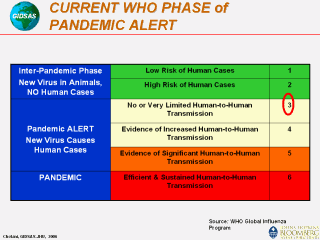| front |1 |2 |3 |4 |5 |6 |7 |8 |9 |10 |11 |12 |13 |14 |15 |16 |17 |18 |19 |20 |21 |22 |23 |24 |25 |26 |27 |28 |29 |30 |31 |32 |33 |review |
 |
Experts at WHO and elsewhere believe that the
world is now closer to another influenza pandemic than at any time since
1968, when the last of the previous century's three pandemics occurred. WHO uses a series of six phases of pandemic alert as a system for informing the world of the seriousness of the threat and of the need to launch progressively more intense preparedness activities. The designation of phases, including decisions on when to move from one phase to another, is made by the Director-General of WHO. Each phase of alert coincides with a series of recommended activities to be undertaken by WHO, the international community, governments, and industry. Changes from one phase to another are triggered by several factors, which include the epidemiological behavior of the disease and the characteristics of circulating viruses. The world is presently in phase 3: a new influenza virus subtype is causing disease in humans, but is not yet spreading efficiently and sustainably among humans. |